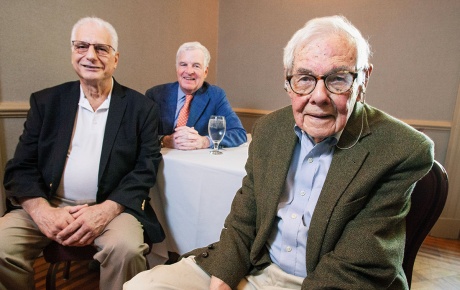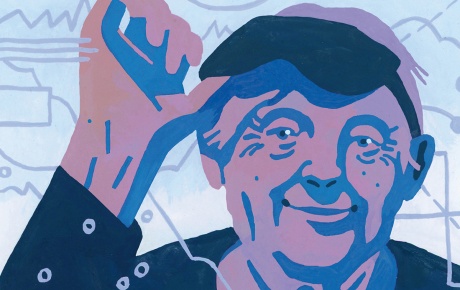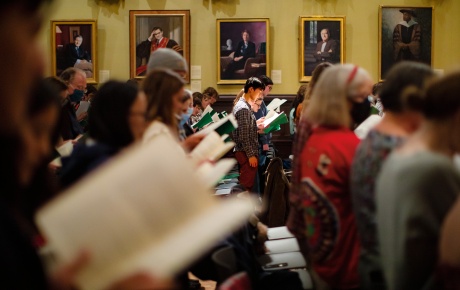It’s a cool, sunny March day in Austin, Texas. The real heat is still months away. Young people are running about chasing Frisbees. But an urgent command from the edge of the field serves as a reminder—to those few who need reminding—that this isn’t just another day at the park.
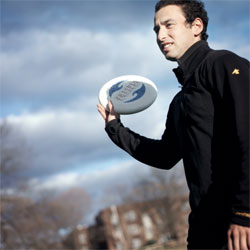
A young man in a black jersey leaves his feet, thrusting his arms forward through the air. For a moment he’s suspended horizontally over the grass. Then the disc reaches his hands—just ahead of the players trailing him—and sticks. He falls to earth, no longer an angel. A young man in a white jersey falls behind him. In a single motion the man in black jumps up, fakes left, and flicks the Frisbee right around his defender. Caught. Passed. Caught.
A great-tailed grackle twangs in the Texas breeze. But the song of the devil bird is drowned out by another call from the sidelines.
“Dump and swing!”
The seven men in black pass the Frisbee in staggered bursts among them, each burst aimed at moving the disc downfield. In response, the white shirts form a “cup,” a common defense in which three players chase the Frisbee around the field while the other four defend the remaining space. When the cup works, it can grind play to a virtual halt. After eight long minutes, the disc is still in the black team’s hands, but just a few yards closer to the end zone. The cup is chasing, harder now; the sideline’s shouting louder. Players hurl themselves precisely through the air, mimicking the disc they seek.
This is Ultimate Frisbee, a sport that combines the aerobics of soccer with the strategy of football and the grace of basketball. The purpose of the game is simple: Two teams of seven players line up at each end of a soccer-size field. One team launches the 175-gram disc to the other, which receives it and attempts to take it down the field and catch it in the opponents’ end zone. One goal earns a point; the first team to score fifteen wins. No player holding the disc is permitted to move; it must be passed from player to player, and there can be no intentional physical contact between any two of them.
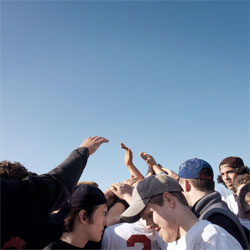
The black-shirted team I am watching is Ultimate Frisbee’s defending national champion: Brownian Motion, the Brown men’s team. It is competing this weekend at Centex, college Ultimate’s toughest endurance test and a crucial warm-up for the national championships, which are held in May. The winning team at Centex must win eight games—some twelve grueling hours of Ultimate—over only two days. (The champion at Nationals, by comparison, will play a maximum of seven games over three days.) Looking out across a dozen other fields, a battle raging on each of them, I decide I need a drink. I’m exhausted, and I’m just watching.
About 100,000 people—300 college teams in all—play Ultimate Frisbee in the United States; the number grows every year. About two dozen of those teams are here competing in Austin. As defending champions, Brownian Motion is closely watched, and although the team will lose more games today than it will win, it has the distinction of being coached by Joshua “Zip” Ziperstein ’05, one of the best players in Ultimate history.
Yet Ziperstein, and Ultimate itself, remain obscure. One problem may be that a Frisbee is a disc, not a ball, the traditional object of sport. (When it’s inverted, as most Ultimate players know, it can hold five cans of beer—try doing that with a ball.) On top of that, a Frisbee evokes images of stoned-out hippies and lazy summers on the beach. To assert Ultimate’s legitimacy, on October 7, 1976, the Brown University Intercollegiate Frisbee Team signed a constitution that formally—and forcefully—declared the Summer of Love had nothing to do with this sport. The document set out “to establish and maintain a group of persons interested in the sport ‘Ultimate Frisbee’ … a unique and serious game with established rules of play and conduct.” Signed by a coed group of fourteen students whose greatest aspiration was credibility, not championships, this constitution is still displayed on the Brownian Motion Web site.

In truth, Ultimate has hardly shed its counterculture roots. The sport is self-officiated—there are no umpires or referees—in keeping with Ultimate’s central tenet, the so-called Spirit of the Game, which holds that respect, adherence to the rules, and the joy of play should guide the sport. Despite Ultimate’s intensely competitive nature and its recent forays in the mainstream—a Wham-O Frisbee sponsored instructional video sanctioned by the Ultimate Players Association (UPA) has sold more than 300,000 copies, many of them at WalMart—the sport’s guiding principle has remained impressively intact.
On the first day of the Centex tournament in Austin, for example, on a field adjacent to the one where Brownian Motion is playing the top-ranked Wisconsin Squid, a controversy erupts over whether or not an illegal handoff had been committed.
“Handoff!” a player on defense declares.
“No way, I dropped it towards him.”
“He grabbed it from you.”
“It left my hands”
“I’ve never called a hand-off before, man. That’s the only one I’ve ever seen. Turn over.”
“That was a handoff bro. I was standing right here.”
Suddenly almost everyone within twenty yards is hashing out the dispute until, eventually, a consensus emerges and play resumes.
By combining an almost naively pure approach to sport with vigorous athleticism, Ultimate has managed to attract some surprising athletes in recent years. One key to last year’s championship was the addition of Jarrod Lynn ’05, a senior backup quarterback on the football team. “I was impressed with how closely Brown club Ultimate compared to Brown Varsity D-1A football in terms of strategy, competitiveness, and physical training,” Lynn says. “But there’s so much more encouragement, and every guy on the team really loves this game.”
Colin Mahoney ’07, a soccer recruit and now a Brownian Motion cocaptain, switched sports his freshman year. “I’ve never felt so strongly about a team in any of the other sports I’ve played,” Mahoney says. “I push myself because I’m so inspired by the others, as players and people. That’s the thing about Ultimate—most people do it for the downtime and friendships as much as for the playing and competing.”
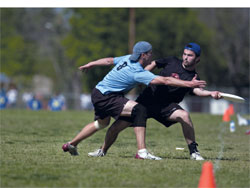
Athletes of this caliber are one reason the men’s Brownian Motion team has established a tradition of excellence. (The name refers to a phenomenon in physics involving chaotic particles; the women’s team is known as Disco Inferno.) Since 1999 four Brown players—Fortunat Mueller ’99, ’00 ScM, Justin Safdie ’00, Pauline Lauterbach ’02, and Josh Ziperstein ’05—have won the Callahan Award, Ultimate’s Heisman Trophy. Two more have been runners-up. Twice in this time span the men’s team has finished first in the country. In fact, since 1998 Brownian Motion has finished in the top eight all but once, despite a constantly changing roster.
For the past ten years, no other Ultimate team in the country has been as consistently good. Yet during the previous twenty years, the Brown team had never played a major tournament game. The turning point came when a quiet engineer named Fortunat Mueller joined the team. As former captain William Arnold ’05 puts it, “Forch brought the team into the modern era.” By the time he was a sophomore, Mueller had become a team captain; two years later he was Brown’s first Callahan winner. As a fifth-year senior (Ultimate athletes have five-year eligibility) he led Brown to its first championship, in which he scored the crucial first point.
“He took off for the end zone, and I didn’t hesitate,” says former captain Moses Rifkin ’00. “I threw it into the wind as hard as I could, and I felt I’d thrown it perfectly. But the wind never caught it and it was going straight out of bounds. You can see [Mueller] in the video, checking where the line is, planting his toes inside it, leaning forward to catch the disc. When I show that video to the kids I coach, they always oooh and aaah.”
According to another former captain, Harper Alexander ’01, Mueller could flip a mental switch and instantly turn himself from a relatively shy and nerdy student into one of the most dominant players the sport has ever seen. “Fortunat was a leader like I had never seen before and have never seen since,” says Alexander, “which is not to say that he was flawless. But he was fascinating and inspiring, and I think that everybody on the team looked up to him in a way that, now that I’m twenty-six, seems insane. He dripped confidence in practice and game situations, and it rubbed off.” Indeed. A group of goofy, formerly unambitious young men, most of whom had much less talent than Mueller, began to take the Ultimate world by storm.
That this is a little-known fact at Brown is an indication of how marginal Ultimate remains as a college sport. While the Ultimate Player’s Association (UPA) has 22,000 members and a million-dollar budget, Brown’s national champions still sell team discs between classes to pay their travel expenses to tournaments. In fact, if you were on the main Green last spring, on nice days you may have seen a few young men—Ziperstein among them—selling Frisbees to pay for team expenses.
Ziperstein is about as good as it gets. Last August, after earning a degree in biomedical engineering, he led the United States to a gold medal in Ultimate at the World Games—the Olympics for non-Olympic sports—in Duisburg, Germany. He was both the youngest member of the U.S. team and its leading scorer.
Four years earlier, Ziperstein had yet to play a single game of Ultimate. As a senior at Amherst Regional High School in Massachusetts, he was a talented soccer player and student who regarded Ultimate with the usual skepticism. That year he picked up a disc in response to repeated harassment from a Frisbee-playing friend. “He kept telling me how awesome Ultimate was,” Ziperstein says. “I was like, ‘Yeah, whatever. I’ll try it at some point.’ One day I finally got around to it.”
Ziperstein arrived at Brown in 2001, a year and a half after Mueller led the school to its first national championship, and according to Alexander, “started the 2001 season as one of several good freshmen and one of the top eight players on the team. By the end of the season he was the best player on the team without question.” With less than a year of experience in the sport, Ziperstein was better than his four captains, all of whom had been on the 2000 national championship team, and two of whom had eight more years of experience and had won junior division world championships.
According to Nathan Wicks, his coach at Brown and at Death or Glory, the renowned Boston club team on which Ziperstein still plays, “Zip is absolutely one of the top three or four players in the world, and probably the best I’ve ever coached or played with.”
This is not a case of a coach who’s enamored to the point of hyperbole with his best player. It’s the consensus among the leaders of the sport. Ted Munter, the coach of Team USA at the World Games, told me that Ziperstein’s talent can hardly be overstated. “By my assessment,” he says, “no one in the world is as fast and as quick. Every time the disc moves, a player theoretically has countless options, such that a hundred things might go on at any given point. Most players will do about ten things right, great players twenty-five, superstars thirty plus. Zip does something like fifty. His on-field execution and IQ are as good as there is.”
At last year’s Nationals, Ziperstein was everywhere, scoring on deep passes, lighting up the other team’s marquee players, and helping out on defense. Late in the game he sprinted to back up a teammate on a pass, even though he was thirty yards away, diving at the last moment to pull in a twice-deflected throw and putting Brown up for good.
Now, as Brownian Motion’s assistant coach, a part-time job he does in addition to working as a lab technician in the AIDS research center at Massachusetts General Hospital, Ziperstein is helping the team get what it needs to compete. Ultimate, like rugby and sailing, is a club sport at Brown, which means it can expect less financial and fan support than established varsity sports, as well as more logistical challenges. Ultimate is also a club sport, though, in the sense that it’s a relatively small, tight-knit—some might say cultlike—community of friends.
“I remember practicing in weird clothes and then watching The Simpsons with the entire team,” says former captain Moses Rifkin ’00. “I remember giving each other weird nicknames and sitting around after games working very hard on cheers for the other teams”—all while being driven to win.
This dynamic is typical of the sport, thanks to the frequent weekend tournaments of fall and spring. “I think Frisbee is a culturally unique sport because of tournament play,” says Ben Wiseman ’05. “Unlike athletes in other sports, players on Frisbee teams go to tournaments where hundreds of players come together for an entire weekend. You end up seeing the same people repeatedly, chatting with them on the field, partying with them afterwards. None of us get the resources of a varsity team, and I think we bond over that as well. We sleep on floors, pay for all our expenses, and practice far away from school. We’ve got to stick together.”
Thanks to Ultimate’s growing popularity, official support is growing. “The biggest single problem with the way Brown handles club sports is that there is no clear system,” says Josh Champagne ’05, who has worked with the Brown athletic department to improve the situation over the last few years. “Different teams are administered in different ways. There’s no one [at Brown] whose sole job it is to look out for club sports, though the athletics department has been really responsive recently to our requests for help.”
If former Brownian Motion captain Kyle Weisbrod ’02, the UPA’s first director of youth development, is right, many of the sport’s struggles will significantly decrease in the next fifteen years as “more kids begin to choose schools based on Ultimate.” Ultimate is now being taught by nearly two thirds of high school physical education teachers in the United States. Sixteen states now have UPA-sanctioned high school championships, up from zero four years ago. College Sports Television (CSTV) will begin its fourth year of covering the college Ultimate championships in 2006. Alumni are donating more to the Ultimate programs at their alma maters, and the distribution of the UPA’s Ultimate instructional video, through the sale of Wham-O Frisbees at sporting-goods stores nationwide, has taken the sport into more backyards and parks than anyone at the UPA would have imagined five years ago.
“I mean, we’re getting calls from people as far apart as South Carolina and the Yukon, all wanting to learn more about the game,” says Weisbrod. “It’s incredible. The sport is entering uncharted terrain. The big question, though, with all the sport’s recent successes, is whether the Spirit of the Game will survive.”
“Don’t you wish you could play?” I ask Ziperstein in Austin as Brown drops a tough Centex game, 15–7, to the Squids who were eliminated at Nationals last year by Stanford, a team Brown beat handily en route to the championship.
“Absolutely,” Ziperstein tells me, holding his clipboard in one hand and a disc in the other. “It’s always hard being on the sidelines, especially as a player turned coach, and even more so at a program like we have at Brown, where we’ve got to do some rebuilding this year.”
Eleven of Brown’s top fourteen players from the 2005 championship team graduated last May (in a special ceremony a few days before Commencement so that they could attend Nationals the same week). Only four of the players on this year’s team started a game last year. More than half are underclassmen. Seven are freshmen, only one of whom played Ultimate before matriculating last fall. As Centex is showing, this team has great promise, but last year’s success may be elusive.
Don’t tell that to the players, though. “We learned at Centex that we are a very young team,” says cocaptain Reid Hopkins ’06, who didn’t learn the nuances of Ultimate until he came to Brown four years ago. “I’m consistently amazed that we do as well as we do. Our basic skills aren’t that strong. But at Centex we showed that we have a lot of heart, great physical ability, and a huge upside. I think we’re going to go to Nationals and upset some teams this year.”
I stand behind him and watch. After a long stalemate on offense, Brown loses the disc in the wind. Wisconsin takes advantage of the mistake and immediately scores on a Hail Mary pass, a “huck” in Ultimate-speak, caught deep in the end zone. Zip toes the sideline for a moment, then pulls aside Mike Vandenberg ’08, one of Brownian Motion’s most talented young players. The coach mimes a defensive stance, throws an imaginary disc, and points to an empty spot on the field. Mike nods, understanding, and heads back to the line.
Eventually, Brownian Motion falls out of contention at Centex. By Sunday afternoon, having lost more games in the past thirty-six hours than it dropped during all of last season, the team is on the sidelines. But Ziperstein is unfazed.
As he and I watch Wisconsin finish off Florida for the Centex title, he methodically devours a burrito the size of his forearm. Between bites, he tells me that there’s no reason why Brown can’t perform well at Nationals this year, continuing its dynastic run. “Our goal is to get there, turn some heads, and give these young guys the experience of playing on that stage,” he says. “I doubt we’ll win the championship, but the way we’ve been steadily improving, who knows?”
For a moment I stop asking questions and simply watch the ballet unfold on the field. A player launches himself through the air, lunging for a disc cutting sharply through the breeze. Not a chance, I think.
Ziperstein, as though he’s read my mind, says, “Watch. He’ll get it.” And in the corner of the end zone, he does.
Charles Bethea, who began playing Ultimate in high school, is an editorial researcher at Outside magazine.


